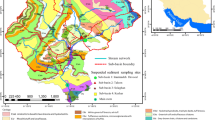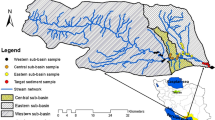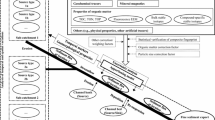Abstract
Purpose
Knowledge of suspended sediment provenance in mesoscale catchments is important for applying erosion control measures and best management practices as well as for understanding the processes controlling sediment transport in the critical zone. As suspended sediment fluxes are highly variable in time, particularly given the variability of soil and rainfall properties in mesoscale catchments, knowledge of sediment provenance at high temporal resolution is crucial.
Materials and methods
Suspended sediment fluxes were analyzed at the outlet of a 42-km2 Mediterranean catchment belonging to the French critical zone observatory network (OZCAR). Spatial origins of the suspended sediments were analyzed at high temporal resolution using low-cost analytical approaches (color tracers, X-ray fluorescence, and magnetic susceptibility). As the measurements of magnetic susceptibility provide only one variable, they were used for cross-validation of the results obtained with the two alternative tracing methods. The comparison of the tracer sets and three mixing models (non-negative least squares, Bayesian mixing model SIMMR, and partial least squares regression) allowed us to estimate different sources of errors inherent in sediment fingerprinting studies and to assess the challenges and opportunities of using these fingerprinting methods.
Results and discussion
All tracer sets and mixing models could identify marly badlands as the main source of suspended sediments. However, the percentage of source contributions varied between the 11 flood events in the catchment. The mean contribution of the badlands varied between 74 and 84%; the topsoils on sedimentary geology ranged from 12 to 29% and the basaltic topsoils from 1 to 8%. While for some events the contribution remained constant, others showed a high within-event variability of the sediment provenance. Considerable differences in the predicted contributions were observed when different tracer sets (mean RMSE 19.9%) or mixing models (mean RMSE 10.1%) were used. Our result shows that the choice of the tracer set was more important than the choice of the mixing model.
Conclusions
These results highlighted the importance of using multi-tracer multi-model approaches for sediment fingerprinting in order to obtain reliable estimates of source contributions. As a given fingerprinting approach might be more sensitive to one type of error, i.e., source variability, particle size selectivity, multi-tracer ensemble predictions allow to detect and quantify these potential biases. High sampling resolution realized with low-cost methods is important to reveal within- and between-event dynamics of sediment fluxes and to obtain reliable information of main contributing sources.









Similar content being viewed by others
References
Andrieu J (2015) Landcover map Claduègne catchment, ESPRI/IPSL. https://doi.org/10.14768/mistrals-hymex.1381
Barthod LRM, Liu K, Lobb DA, Owens PN, Martínez-Carreras N, Koiter AJ, Petticrew EL, McCullough GK, Liu C, Gaspar L (2015) Selecting color-based tracers and classifying sediment sources in the assessment of sediment dynamics using sediment source fingerprinting. J Environ Qual 44:1605–1616
Ben Slimane A, Raclot D, Evrard O, Sanaa M, Lefèvre I, Ahmadi M, Tounsi M, Rumpel C, Ben Mammou A, Le Bissonnais Y (2013) Fingerprinting sediment sources in the outlet reservoir of a hilly cultivated catchment in Tunisia. J Soils Sediments 13:801–815
Ben-Dor E, Irons JR, Epema GF (1998) Soil reflectance. In: Rencz AN (ed) Remote sensing for the earth sciences. Manual of remote sensing. Wiley, New York, pp 111–188
Blake WH, Wallbrink PJ, Doerr SH, Shakesby RA, Humphreys GS (2006) Magnetic enhancement in wildfire-affected soil and its potential for sediment-source ascription. Earth Surf Process Landf 31(2):249–264
Boudevillain B, Delrieu G, Galabertier B, Bonnifait L, Bouilloud L, Kirstetter PE, Mosini ML (2011) The Cévennes-Vivarais Mediterranean Hydrometeorological Observatory database. Water Resour Res 47:1–6
Brantley SL, Mcdowell WH, Dietrich WE, White TS, Kumar P, Anderson SP, Chorover J, Lohse KA, Bales RC, Richter DD, Grant G, Gaillardet J (2017) Designing a network of critical zone observatories to explore the living skin of the terrestrial Earth. Earth Surf Dyn 5:841–860
Braud I, Ayral PA, Bouvier C, Branger F, Delrieu G, Le Coz J, Nord G, Vandervaere JP, Anquetin S, Adamovic M, Andrieu J, Batiot C, Boudevillain B, Brunet P, Carreau J, Confoland A, Didon-Lescot JF, Domergue JM, Douvinet J, Dramais G, Freydier R, Gérard S, Huza J, Leblois E, Le Bourgeois O, Le Boursicaud R, Marchand P, Martin P, Nottale L, Patris N, Renard B, Seidel JL, Taupin JD, Vannier O, Vincendon B, Wijbrans A (2014) Multi-scale hydrometeorological observation and modelling for flash flood understanding. Hydrol Earth Syst Sci 18:3733–3761
Brils J (2008) Sediment monitoring and the European Water Framework Directive. Ann Ist Super Sanita 44(3):218–223
Brosinsky A, Foerster S, Segl K, López-Tarazón JA, Piqué G, Bronstert A (2014a) Spectral fingerprinting: characterizing suspended sediment sources by the use of VNIR-SWIR spectral information. J Soils Sediments 14:1965–1981
Brosinsky A, Foerster S, Segl K, Kaufmann H (2014b) Spectral fingerprinting: sediment source discrimination and contribution modelling of artificial mixtures based on VNIR-SWIR spectral properties. J Soils Sediments 14:1949–1964
Commission Internationale de l’Eclairage (CIE) (1978) Recommendations on uniform color spaces, color differences, and psychometric color terms. Calorimetry CIE, Paris Suppl. No. 2 to publication no. 15, Paris
Collins AL, Walling DE, Leeks GJL (1997) Source type ascription for fluvial suspended sediment based on a quantitative composite fingerprinting technique. Catena 29:1–27
Collins AL, Walling DE, Webb L, King P (2010) Apportioning catchment scale sediment sources using a modified composite fingerprinting technique incorporating property weightings and prior information. Geoderma 155:249–261
Collins AL, Pulley S, Foster IDL, Gellis A, Porto P, Horowitz AJ (2017) Sediment source fingerprinting as an aid to catchment management: a review of the current state of knowledge and a methodological decision-tree for end-users. J Environ Manag 194:86–108
Cooper JR, Wainwright J, Parsons AJ, Onda Y, Fukuwara T, Obana E, Kitchener B, Long EJ, Hargrave GH (2012) A new approach for simulating the redistribution of soil particles by water erosion: a marker-in-cell model. J Geophys Res 117:1–20
Cooper RJ, Krueger T, Hiscock KM, Rawlins BG (2014) Sensitivity of fluvial sediment source apportionment to mixing model assumptions: a Bayesian model comparison. Water Resour Res 50:9031–9047
Cooper RJ, Krueger T, Hiscock KM, Rawlins BG (2015) High-temporal resolution fluvial sediment source fingerprinting with uncertainty: a Bayesian approach. Earth Surf Process Landf 40:78–92
Dearing JA, Elner JK, Happey-Wood CM (1981) Recent sediment flux and erosional processes in a welsh upland lake-catchment based on magnetic susceptibility measurements. Quat Res 16:356–372
Dearing JA, Morton RI, Price TW, Foster IDL (1986) Tracing movements of topsoil by magnetic measurements: two case studies. Phys Earth Planet Inter 42:93–104
Dearing J, Hu Y, Doody P, James PA, Brauer A (2001) Preliminary reconstruction of sediment-source linkages for the past 6000 yr at the Petit Lac d’Annecy, France, based on mineral magnetic data. J Paleolimnol 25:245–258
de Deckere E, de Cooman W, Leloup V, Meire P, Schmitt C, von der Ohe PC (2011) Development of sediment quality guidelines for freshwater ecosystems. J Soils Sediments 11:504–517
Douglas G, Caitcheon G, Palmer M (2009) Sediment source identification and residence times in the Maroochy River estuary, Southeast Queensland, Australia. Environ Geol 57:629–639
Du P, Walling DE (2017) Fingerprinting surficial sediment sources: exploring some potential problems associated with the spatial variability of source material properties. J Environ Manag 194:4–15
Evrard O, Navratil O, Ayrault S, Ahmadi M, Némery J, Legout C, Lefèvre I, Poirel A, Bonté P, Esteves M (2011) Combining suspended sediment monitoring and fingerprinting to determine the spatial origin of fine sediment in a mountainous river catchment. Earth Surf Process Landf 36:1072–1089
Evrard O, Poulenard J, Némery J, Ayrault S, Gratiot N, Duvert C, Prat C, Lefèvre I, Bonté P, Esteves M (2013) Tracing sediment sources in a tropical highland catchment of central Mexico by using conventional and alternative fingerprinting methods. Hydrol Process 27:911–922
Franks SW, Rowan JS (2000) Multi-parameter fingerprinting of sediment sources: uncertainty estimation and tracer selection. Conference: XIIIth International Conference on Computational Methods in Water Resources Location, Calgary, June 25-29, 2000. Computational methods in Water Resources, pp 1067–1074
Gaillardet J, Braud I, Hankard F, Anquetin S, Bour O, Dorfliger N, de Dreuzy JR, Galle S, Galy C, Gogo S, Gourcy L, Lagoun F, Longuevergne L, Le Borgne T, Naaim-Bouvet F, Nord G, Simonneaux V, Six D, Tallec T, Valentin C (2018) OZCAR: the French network of critical zone observatories. Vadose Zone J 17:180067. https://doi.org/10.2136/vzj2018.04.0067
Grangeon T, Legout C, Esteves M, Gratiot N, Navratil O (2012) Variability of the particle size of suspended sediment during highly concentrated flood events in a small mountainous catchment. J Soils Sediments 12:1549–1558
Guo L, Lin H (2016) Critical zone research and observatories: current status and future perspectives. Vadose Zone J 15. https://doi.org/10.2136/vzj2016.06.0050
Haddadchi A, Ryder DS, Evrard O, Olley J (2013) Sediment fingerprinting in fluvial systems: review of tracers, sediment sources and mixing models. Int J Sediment Res 28:560–578
Haddadchi A, Olley J, Laceby P (2014) Accuracy of mixing models in predicting sediment source contributions. Sci Total Environ 497–498:139–152
Huon S, Evrard O, Gourdin E, Lefèvre I, Bariac T, Reyss JL, des Tureaux TH, Sengtaheuanghoung O, Ayrault S, Ribolzi O (2017) Suspended sediment source and propagation during monsoon events across nested sub-catchments with contrasted land uses in Laos. J Hydrol: Regional Studies 9:69–84
IGN France (2009) BD ORTHO. http://professionnels.ign.fr/bdortho. Accessed 05 Feb 2019
Koiter AJ, Lobb DA, Owens PN, Petticrew EL, Tiessen KHD, Li S (2013) Assessing the sources of suspended sediments in the streams of an agricultural watershed in the Canadian prairies using caesium-137 as a tracer. J Soils Sediments 13:1676–1691
Krause AK, Franks SW, Kalma JD, Loughran RJ, Rowan JS (2003) Multi-parameter fingerprinting of sediment deposition in a small gullied catchment in SE Australia. Catena 53:327–348
Laceby JP, Olley J (2015) An examination of geochemical modelling approaches to tracing sediment sources incorporating distribution mixing and elemental correlations. Hydrol Process 29:1669–1685
Laceby JP, Evrard O, Smith HG, Blake WH, Olley JM, Minella JPG, Owens PN (2017) The challenges and opportunities of addressing particle size effects in sediment source fingerprinting: a review. Earth-Science Rev 169:85–103
Lawson CL, Hanson RJ (1974) Solving least squares problems. Prentice-Hall, Englewood Cliffs, p 340
Lees JA (1997) Mineral magnetic properties of mixtures of environmental and synthetic materials: linear additivity and interaction effects. Geophys J Int 131:335–346
Legout C, Poulenard J, Nemery J, Navratil O, Grangeon T, Evrard O, Esteves M (2013) Quantifying suspended sediment sources during runoff events in headwater catchments using spectrocolorimetry. J Soils Sediments 13:1478–1492
Maher BA (1986) Characterisation of soils by mineral magnetic measurements. Phys Earth Planet Inter 42:76–92
Martínez-Carreras N, Udelhoven T, Krein A, Gallart F, Iffly JF, Ziebel J, Hoffmann L, Pfister L, Walling DE (2010a) The use of sediment colour measured by diffuse reflectance spectrometry to determine sediment sources: application to the Attert River catchment (Luxembourg). J Hydrol 382:49–63
Martínez-Carreras N, Krein A, Udelhoven T, Gallart F, Iffly JF, Hoffmann L, Pfister L, Walling DE (2010b) A rapid spectral-reflectance-based fingerprinting approach for documenting suspended sediment sources during storm runoff events. J Soils Sediments 10:400–413
Mevik B-H, Liland RW, Hovde K (2016) plsr{pls}, R function, [online] Available from: https://cran.r-project.org/web/packages/pls/pls.pdf. Accessed 05 Feb 2019
Molinié G, Ceresetti D, Anquetin S, Creutin JD, Boudevillain B (2012) Rainfall regime of a mountainous Mediterranean region: statistical analysis at short time steps. J Appl Meteorol Climatol 51:429–448
Motha JA, Wallbrink PJ, Hairsine PB, Grayson RB (2003) Determining the sources of suspended sediment in a forested catchment in southeastern Australia. Water Resour Res 39:1–14
Mullen KM, Van Stokkum IHM (2015) nnls{nnls}, R function, [online] Available from: https://cran.r-project.org/web/packages/nnls/nnls.pdf. Accessed 05 Feb 2019
Nizou J, Demory F, Dubrulle-Brunaud C (2016) Monitoring of dredged-dumped sediment dispersal off the bay of the seine (northern France) using environmental magnetism. Compt Rendus Geosci 348:451–461
Nord G, Boudevillain B, Berne A, Branger F, Braud I, Dramais G, Gérard S, Le Coz J, Legout C, Molinié G, Van Baelen J, Vandervaere J, Andrieu J, Aubert C, Calianno M, Delrieu G, Grazioli J, Hachani S, Horner I, Huza J, Le Boursicaud R, Raupach T, Teuling AJ, Uber M, Vincendon B, Wijbrans A (2017) A high space–time resolution dataset linking meteorological forcing and hydro-sedimentary response in a mesoscale Mediterranean catchment (Auzon) of the Ardèche region, France. Earth Syst Sci Data 9:221–249
Nosrati K, Govers G, Semmens BX, Ward EJ (2014) A mixing model to incorporate uncertainty in sediment fingerprinting. Geoderma 217–218:173–180
Nosrati K, Collins AL, Madankan M (2018) Fingerprinting sub-basin spatial sediment sources using different multivariate statistical techniques and the modified MixSIR model. Catena 164:32–43
Palazón L, Navas A (2017) Variability in source sediment contributions by applying different statistic test for a Pyrenean catchment. J Environ Manag 194:42–53
Palazón L, Latorre B, Gaspar L, Blake WH, Smith HG, Navas A (2016) Combining catchment modelling and sediment fingerprinting to assess sediment dynamics in a Spanish Pyrenean river system. Sci Total Environ 569-570:1136–1148
Parnell AC (2016) simmr, R package, [online] Available from: https://cran.rproject.org/web/packages/simmr/simmr.pdf. Accessed 05 Feb 2019
Parnell AC, Inger R, Bearhop S, Jackson AL (2010) Source partitioning using stable isotopes: coping with too much variation. PLoS One 5:1–6. https://doi.org/10.1371/journal.pone.0009672
Parnell AC, Phillips DL, Bearhop S, Semmens BX, Ward EJ, Moore JW, Jackson AL, Grey J, Kelly DJ, Inger R (2013) Bayesian stable isotope mixing models. Environmetrics 24:387–399
Peart MR, Walling DE (1986) Fingerprinting sediment source : the example of a drainage basin in Devon, UK. In: Drainage basin sediment delivery, IAHS Publ 159. IAHS Press, Wallingford, pp 41–55
Perks MT, Warburton J, Bracken LJ, Reaney SM, Emery SB, Hirst S (2017) Use of spatially distributed time-integrated sediment sampling networks and distributed fine sediment modelling to inform catchment management. J Environ Manag 202:469–478
Phillips DL, Inger R, Bearhop S, Jackson AL, Moore JW, Parnell AC, Semmens BX, Ward EJ (2014) Best practices for use of stable isotope mixing models. Can J Zool 92:823–835
Poulenard J, Legout C, Némery J, Bramorski J, Navratil O, Douchin A, Fanget B, Perrette Y, Evrard O, Esteves M (2012) Tracing sediment sources during floods using diffuse reflectance infrared Fourier transform spectrometry (DRIFTS): a case study in a highly erosive mountainous catchment (Southern French Alps). J Hydrol 414–415:452–462
Pulley S, Rowntree K (2016) The use of an ordinary colour scanner to fingerprint sediment sources in the South African Karoo. J Environ Manag 165:253–262
Pulley S, Foster I, Antunes P (2015) The uncertainties associated with sediment fingerprinting suspended and recently deposited fluvial sediment in the Nene river basin. Geomorphology 228:303–319
Pulley S, Van Der Waal B, Collins AL, Foster IDL, Rowntree K (2017) Are source groups always appropriate when sediment fingerprinting? The direct comparison of source and sediment samples as a methodological step. River Res Appl 33:1–11
Small IF, Rowan JS, Franks SW, Wyatt A, Duck RW (2004) Bayesian sediment fingerprinting provides a robust tool for environmental forensic geoscience applications. Geol Soc Lond Spec Publ 232:207–213
Smith HG, Evrard O, Blake WH, Owens PN (2015) Preface—Addressing challenges to advance sediment fingerprinting research. J Soils Sediments 15:2033–2037
Vale S (2016) Application and evaluation of sediment fingerprinting techniques in the Manawatu River catchment, New Zealand. PhD Thesis, Massey University 256
Vercruysse K, Grabowski RC, Rickson RJ (2017) Suspended sediment transport dynamics in rivers: multi-scale drivers of temporal variation. Earth-Sci Rev 166:38–52
Walden J, Slattery MC, Burt TP (1997) Use of mineral magnetic measurements to fingerprint suspended sediment sources: approaches and techniques for data analysis. J Hydrol 202:353–372
Walling DE, Peart M, Oldfield F, Thompson R (1979) Suspended sediment sources identified by magnetic measurements. Nature 281:110–113
Walling DE, Woodward JC, Nicholas AP (1993) A multi-parameter approach to fingerprinting suspended-sediment sources. In: Tracers in hydrology, IAHS Publ 215. IAHS Press, Wallingford, UK, pp 329–338
Wold S, Sjöström M, Eriksson L (2001) PLS-regression: a basic tool of chemometrics. Chemom Intell Lab Syst 58:109–130
Yu L, Oldfield F (1993) Quantitative sediment source ascription using magnetic measurements in a reservoir-catchments system near Nijar, S.E. Spain. Earth Surf Proc Landform 18:441–454
Yu L, Oldfield F (1989) A multivariate mixing model for identifying sediment source from magnetic measurements. Quat Res 32:168–181
Acknowledgments
We want to thank three anonymous reviewers for their comments on an earlier version of the manuscript that were very helpful to improve this paper.
Funding
This work was funded by the Hymex program (French National Research Agency, ANR) and the OHM-CV which is supported by the Institut National des Sciences de l’Univers (INSU/CNRS), the French Ministry for Education and Research, the Environment Research Cluster of the Rhône-Alpes Region, the Observatoire des Sciences de l’Univers de Grenoble (OSUG), and the SOERE Réseau des Bassins Versants (Alliance Allenvi) and belongs to the OZCAR Research Infrastructure. The PhD project of Magdalena Uber is financed by a scholarship granted by Université Grenoble Alpes.
Author information
Authors and Affiliations
Corresponding authors
Additional information
Responsible editor: Alexander Koiter
Publisher’s note
Springer Nature remains neutral with regard to jurisdictional claims in published maps and institutional affiliations.
Rights and permissions
About this article
Cite this article
Uber, M., Legout, C., Nord, G. et al. Comparing alternative tracing measurements and mixing models to fingerprint suspended sediment sources in a mesoscale Mediterranean catchment. J Soils Sediments 19, 3255–3273 (2019). https://doi.org/10.1007/s11368-019-02270-1
Received:
Accepted:
Published:
Issue Date:
DOI: https://doi.org/10.1007/s11368-019-02270-1




